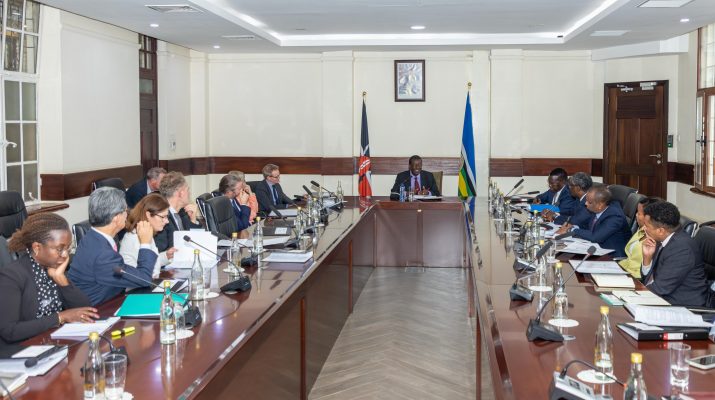By Grace Gilo
Prime Cabinet Secretary and Cabinet Secretary for Foreign and Diaspora Affairs, H.E. Musalia Mudavadi, met with envoys from the G7 countries and other development partners to review the progress of key transport projects aimed at reducing congestion in the Nairobi Metropolitan Area.
The meeting took place at Railways Headquarters and was attended by Roads and Transport Cabinet Secretary Hon. Davis Chirchir, along with other senior government officials.
The discussions focused on infrastructure programs designed to improve urban mobility, enhance connectivity, and support sustainable development.
The G7, a group of major advanced economies comprising Canada, France, Germany, Italy, Japan, the United Kingdom, and the United States, was represented by members of the diplomatic corps and Representatives of the European Union, which participates in G7 dialogues, were also present.
Mudavadi reaffirmed the Kenyan government’s commitment to implementing transformative transport solutions that align with the country’s long-term development goals.
“These projects go beyond easing traffic. They are about building a modern, inclusive and livable city that meets the needs of all Kenyans,” he said.
He called on development partners to sustain their support and deepen collaboration as the government accelerates implementation of urban mobility reforms.
British High Commissioner H.E. Neil Wigan reiterated the UK’s strong support for Kenya’s infrastructure agenda, particularly the Railway City initiative.
“We are working closely with the government on the expression of interest and are now awaiting the Request for Proposals (RFP) for the Railways project,” Wigan said.
“This collaboration is a clear example of how international partnerships can deliver practical results,” he reiterated.
According to CS Chirchir, the Government plans to evacuate 30,000 people per hour by 2030 via the Nairobi Railway Central Station. This ambitious target is supported by a multimodal transport ecosystem that includes commuter rail, Bus Rapid Transit (BRT), and non-motorized options.
The Central Station is dubbed the “first mover” project, serving as the nexus of the Nairobi Railway City initiative.
Plans are in place to rehabilitate a total of 165 kilometres of existing commuter rail lines, with new connections in the works to improve access and mobility within Nairobi’s metropolitan zone.
One of the most ambitious proposed additions is the 30.5-kilometre Riruta–Ngong–Kiserian–Ongata Rongai line, which is designed to integrate commuter traffic from rapidly growing satellite towns.
Multiple Bus Rapid Transit (BRT) lines, including routes from Dandora to hospitals, Mama Lucy to Kikuyu, and Ruiru to the CBD, are in various stages of design and implementation, with Phase 1 of Line 3 identified as a priority corridor.
The harmonization of BRT with enhanced road interchange capacities signals serious intent to mainstream high-capacity public transport.
The third consultative meeting of the G7+ Development Partners (G7+DP) Transport Sector Pilot Programme, chaired by the Prime Cabinet Secretary, reviewed progress and focused on strategies to expedite joint resource mobilisation for various project implementations.
“The pilot programmes under review are part of a broader government initiative to modernize public transportation systems through innovation, public-private partnerships and green urban planning,” PCS Mudavadi said.

